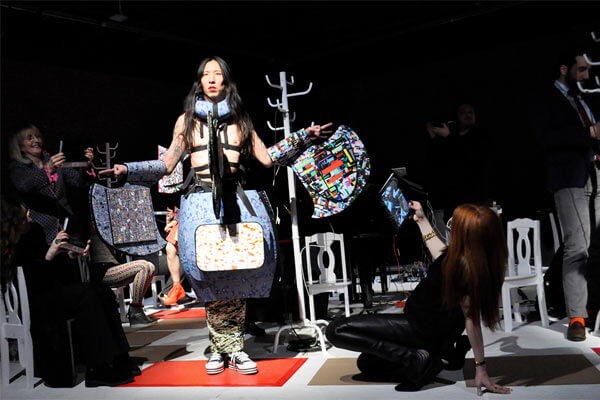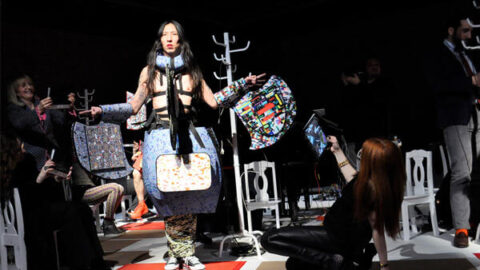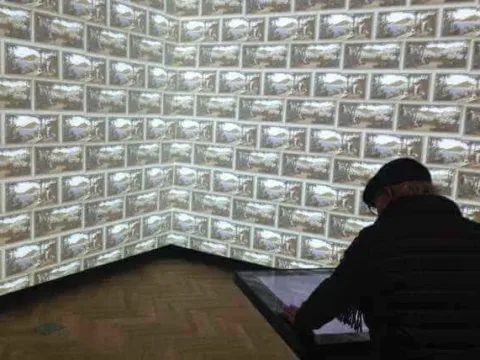 In Lewis Carroll’s Alice’s Adventures in Wonderland, Alice falls into a fantasy world populated by strange creatures and surreal distortions; she finds losing control both liberating and vexing. In The Alices (Walking), Claudia Hart overlays the Alice story on contemporary culture in what she calls a “sculptural opera,” using the confusion, nonsense, and whimsy of Carroll’s tale as a metaphor for life in the digital era. Performed in context of a larger exhibit at Eyebeam, “Second Sight: An Exhibition of New Approaches to Video,” The Alices (Walking) combined the pageantry of a fashion show with interactive video, set to a score with live electronic processing by Edmund Campion.
In Lewis Carroll’s Alice’s Adventures in Wonderland, Alice falls into a fantasy world populated by strange creatures and surreal distortions; she finds losing control both liberating and vexing. In The Alices (Walking), Claudia Hart overlays the Alice story on contemporary culture in what she calls a “sculptural opera,” using the confusion, nonsense, and whimsy of Carroll’s tale as a metaphor for life in the digital era. Performed in context of a larger exhibit at Eyebeam, “Second Sight: An Exhibition of New Approaches to Video,” The Alices (Walking) combined the pageantry of a fashion show with interactive video, set to a score with live electronic processing by Edmund Campion.

At the beginning of the performance on Saturday, March 8, five people in elaborate sculptural costumes slowly circumnavigated the stage: the modern-day “Alices.” Each costume featured large geometric shapes extending from the performers’ bodies, shapes filled in with colorful, pixelated patterns: vibrant scribbles and radiant glitches. With all their asymmetric profusions and patterned-references to web design the Alices looked like digital-era angels, as well as immediately bringing to mind the famous Cubist costumes designed by Picasso for the avant-garde confection Parade in 1917.
As the encumbered Alices walked carefully to their places on stage, a dozen or so audience members, chosen before the performance, took video of them from the stage with tablets pre-loaded interactive software. The pixelated patterns on the Alices’ costumes functioned as algorithmic computer codes which signaled the app on the tablets, sending a feed of video interpolated with words from the piece’s libretto, based on Alice in Wonderland, to a large projection area to the side of the stage. According to Hart, these poetic text animations interpolated in the video evolved from Lewis Carroll by using a special software designed by Alon Zouartez, called Spinabook, which takes “an original text and [creates] legitimate plagiarism, substituting words with their synonyms to create a legal but unethical clone.”

The Alices (Walking) also featured a complex soundscape and score by composer Edmund Campion, professor of music at the University of Berkeley in California and co-director of CNMAT, The Center for New Music and AudioTechnologies. Campion, sitting at a grand piano on stage throughout, designed custom feedback audio software which wove the layers of sound, narration, piano, and spoken word. The extended timbre of the piano served as a continuation of the Alice theme; as the sustains of the piano extended into drones, the piano itself sounded like it had fallen through the rabbit hole, subject to distortion and disorientation just as Alice was. At one point Campion looped a muffled bass line as the Alices engaged in rhythmic stamps and claps; according to the artist’s notes about the piece contact mics and audio sensors were used on stage to process these noise components. The chatter of voices was also a frequent component of the score, and occasionally snippets of the libretto emerged audibly: “Everything is queer today,” or “That’s the great puzzle—who am I?”

If it sounds like a spectacle, it was. As I watched, I looked over the huge crowd that had packed Eyebeam. I wondered what an audience member would take away, especially if not primed with foreknowledge about the fairly complex array of sonic and visual manipulations taking place. Some looked amused, some bored, some stoic. Ironically, some checked their phones, as the tableau before them offered a slightly dystopian vision of a society whose experience is hyper-mediated by technology. The on-stage audience members who continually took videos throughout the performance only watched the Alices through the tablets, and their vision was obscured by nonsensical messages, a counterfeit version of a story based on a highly relativistic world. It reminded me of a digital Tower of Babel; it held a slanted mirror up to our culture, albeit a sadly pixelated one.



